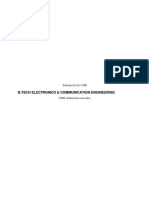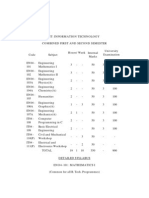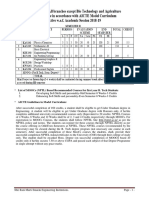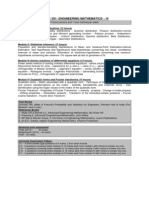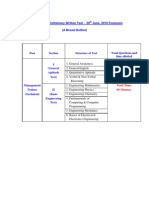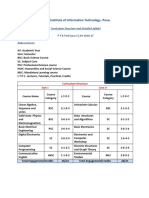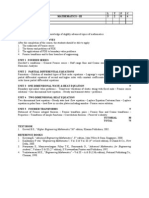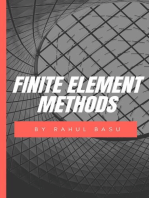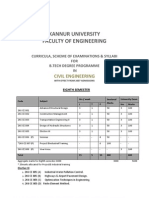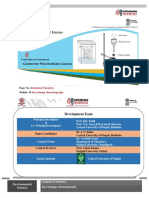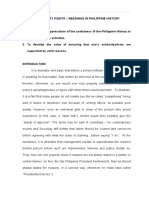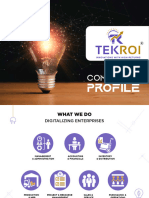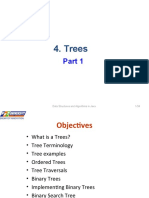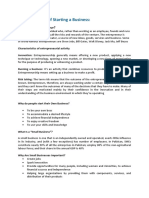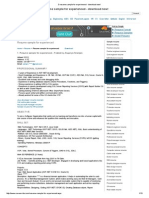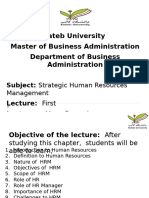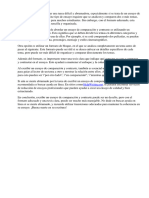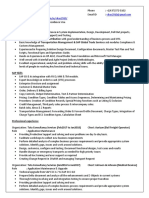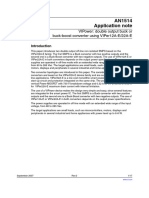KANNUR UNIVERSITY BTech.S1S2 Syllabus
KANNUR UNIVERSITY BTech.S1S2 Syllabus
Uploaded by
Manu K MCopyright:
Available Formats
KANNUR UNIVERSITY BTech.S1S2 Syllabus
KANNUR UNIVERSITY BTech.S1S2 Syllabus
Uploaded by
Manu K MOriginal Title
Copyright
Available Formats
Share this document
Did you find this document useful?
Is this content inappropriate?
Copyright:
Available Formats
KANNUR UNIVERSITY BTech.S1S2 Syllabus
KANNUR UNIVERSITY BTech.S1S2 Syllabus
Uploaded by
Manu K MCopyright:
Available Formats
KANNUR UNIVERSITY
FACULTY OF ENGINEERING
Curricula, Scheme of Examinations & Syllabus for COMBINED I & II SEMESTERS of B.Tech. Degree Programme with effect from 2007 Admissions
2K6 EN101: ENGINEERING MATHEMATICS I 2 hours lecture and 1 hour tutorial per week Module I: Ordinary Differential Equations (16 hours) A brief review of the method of solutions first order equations Separable, homogeneous and linear types Exact equations Orthogonal trajectories General linear second order equationshomogeneous linear equation of the second order with constant coefficients- Fundamental system of solutions Method of variation of parameters Cauchy's equation. Module II: Laplace Transforms (17 hours) Gamma and Beta functions Definition and simple properties Laplace transform Inverse transform Laplace transform of derivatives and integrals Shifting theorems Differentiation and integration of transforms Transforms of unit step function and impulse function Transforms of periodic functions Solutions of ordinary differential equations using Laplace transforms. Module III: Vector differential calculus (18 hours) Functions of more than one variable Idea of partial differentiation Euler's theorem for homogeneous functions Chain rule of partial differentiation application in errors and approximations. Vector function of single variable - differentiation of vector functions Scalar and vector fields Gradient of a scalar field Divergence and curl of vector fields Their physical meanings Relation between the vector differential operators. Module IV: Fourier series and harmonic analysis (15 hours) Periodic functions Trigonometric series Euler formulae Even and odd functions Functions having arbitrary period Half range expansions Numerical method for determining Fourier coefficients Harmonic analysis. Reference Books: 1. Piskunov N, Differential and Integral calculus, MIR Publishers 2. Wylie C R & Barrett L. C., Advanced Engineering Mathematics, Mc Graw Hill 3. Grewal B. S, Higher Engineering Mathematics, Khanna Publishers 4. Kreyszig E., Advanced Engineering Mathematics, Wiley Eastern. 5. Thomas G B, Calculus and Analytic Geometry, Addison Wesley 6. Spigel. , Vector analysis, Schume series, Mc Grawhill 7. Sastri. S. S. Engineering Mathematics, Prentice Hall of India.
Sessional work assessment Assignments 2 tests Total marks University Examination Pattern Q I - 8 short type questions of 5 marks, 2 from each module. Q II - 2 questions A and B of 15 marks from module I with choice to answer any one. Q III - 2 questions A and B of 15 marks from module II with choice to answer any one. Q IV - 2 questions A and B of 15 marks from module III with choice to answer any one. Q V - 2 questions A and B of 15 marks from module IV with choice to answer any one. 2x10 2x15 = 20 = 30 = 50
2K6 EN102: ENGINEERING PHYSICS 2 hours lecture per week Module I: (11 hours) Interference of light: Interference from plane parallel thin films Colours of thin films by reflected light - Newton's rings - Measurement of wave length Thin wedge shaped air film Air wedge Testing of optical planes of surfaces. Diffraction of light: Introduction to Fresnel and Fraunhofer diffraction Distinction between the two diffractions Simple theory of plane transmission grating. Polarization of light: Double refraction Nicol prism Quarter and half wave plates Production and detection of elliptically and circularly polarized light Rotatory polarization Laurent's half shade polarimeter Applications of polarized light. Module II: (11hours) Quantum Mechanics: Newtonian Mechanics and quantum mechanics Uncertainty principle The wave functions Shrodinger wave equation for free particle Potentials in Shrodinger equation Time independent Shrodinger equation - Time dependent Shrodinger equation Expectation values Derivation of Shrodinger equation Application Particle in a box (motion in one dimension ). NMR and ESR: Basic principles of Nuclear Magnetic Resonance (NMR) and Electron Spin Resonance (ESR) Experimental Method for detection of NMR and ESR Applications. Module III: (11 hours) Laser Physics: Basic concepts of laser Spontaneous and stimulated emission Absorption Population inversion Optical pumping Construction and components of laser Ruby laser, Helium-Neon Laser and semiconductor laser Applications Basic principle of Holography and its application. Fibre Optics: Basic principles Fiber construction Fiber dimensions Light propagation in fiber Signal distortion in optical fibers and transmission losses (Brief ideas only) Light Wave communication using optical fibers and its advantages Fiber Amplifiers and EDFAs Applications of optical fibers. Non Destructive Testing : X-rays Properties and production X-ray radiography Stereo Radiography CT scan Ultrasonics properties NDT using ultrasonics Electrical method Magnetic method Ultrasound scanning- MRI scan. Module IV: (13 hours) Electron Theory of Solids : Classical free electron theory drift velocity conductivity relaxation time mean free path temperature dependence of resistivity relation between thermal and electrical conductivities (Weidman Frenz law) Quantum free electron theory density of states Fermi distribution function Fermi energy-Band theory of solids (Qualitative only ) - Band structure of metals, semiconductors and insulators Classifications of semiconductors on the basis of Fermi level and Fermi energy Impurity levels in N-type and P-type semiconductors. Hall effect: Introduction Measurement of Hall voltage and Hall coefficient Importance of Hall effect. Super conductivity: Properties of superconductors Josephson effect and tunneling (qualitative) B.C.S Theory of superconductivity (qualitative) Applications of superconductivity
Reference Books: 1. Brijlal & Subrahmanyam. N, Text Book of Optics, S. Chand 2. Rajendran and Marikani : Applied Physics for Engineers 3 rd edition -TMH 3. A.S.Vasudeva S Modern Engineering Physics , S. Chand 4. Jenkins F.A & White H.E. Fundamentals of Optics, Mc Graw Hill. 5. M. Arumugam : Material science: Anuradha Publications 6. S.O. Pillai Solid State Physics New Age International 7. Srivastva . C.M & Sreenivasan. C. Science Engineering Materials, New Age International Sessional work assessment Assignments 2 tests Total marks University Examination Pattern Q I - 8 short type questions of 5 marks, 2 from each module. Q II - 2 questions A and B of 15 marks from module I with choice to answer any one. Q III - 2 questions A and B of 15 marks from module II with choice to answer any one. Q IV - 2 questions A and B of 15 marks from module III with choice to answer any one. Q V - 2 questions A and B of 15 marks from module IV with choice to answer any one. 2x10 2x15 = 20 = 30 = 50
2K6 EN 103: ENGINEERING CHEMISTRY 2 hours lecture per week Module I: High Ploymers & Lubricants (13 hours) Classification of polymers. Polymerization chain polymerization, condensation polymerization, copolymerization, coordination polymerization, electrochemical polymerization, metathetical polymerization, group transfer polymerization. Mechanism of polymerization. Polymerization technique- bulk polymerization, solution polymerization, suspension polymerization,emulsion polymerization, melt polymerization, solution polycondensation, interfacial condensation, solid and gas phase condensation, Structure- property relationship of polymers. Compounding and moulding of polymers. Important plastics their production,properties and uses. Thermoplastic resins (PE,PP,PVC,PVA,PMMA,PS), thermosetting resins (Bakelite, Urea formaldehyde, Silicones), fibers(nylon 6, nylon 66, cellulose fibers, Dacron, Kevlar) Elastomers Natural rubber production,structure, properties, compounding & vulcanization. Synthetic rubbers- (Buna, neoprene, thiokols, polyurethane,silicon rubber) Lubricants: Theory of friction, mechanism of lubrication, classification of lubricants- liquid,semi solid, solid and synthetic lubricants. Properties of lubricants. (viscosity index, cloud point, pour point, flash point, fire point, corrosion stability, emulsification, aniline point). Additives and their functions. Module II: Electrochemistry (11hours) Electrode potential and electromotive force.Nernst equation for electrode potential. Measurement of EMF and electrode potential. Types of electrodes. Primary and secondary reference electrodes. Electrochemical series. Galvanic cells and concentration cells. Determination of pH using glass electrode. Secondary cells- lead acid cells,Ni-Cd cell, Edisson cell. Fuel cell- Hydrogen-oxygen fuel cell. Acid and bases. Lowry- Bronsted and Lewis concepts. Concept of pH- pH measurements.(instrumental details required) Dissociation constants- potentiometric titrations. Buffer solutions. Henderson equation for calculation of pH. Module III: Corrosion(11 hours) Corrosion and its control- Theories of corrosion. Different types of corrosion. Factors affecting corrosion. Protective coatings. Self protecting corrosion products. Pretreatment of surfaces. Coatingorganic,inorganic coatings- galvanizing, tinning, electroplating, electroless plating,anodisation, passivation by chemical treatment, cathodic protection. Properties and functions of ingredients in paints, varnishes and enamels. Module IV: Fuels & Environmental Pollution(13 hours) Classification of fuels- solids, liquid & gaseous fuels, Determination of calorific value. Solid fuelswood, peat, lignite, coal, Proximate analysis, Petroleum and its refining, fractions and their uses. Cracking and reforming. Petrol knock and octane number. Gaseous fuels- Natural gas, coal gas, acetylene. Combustion calculation. Air-fuel ratio. Pollution- Classification (global, regional and local with examples). Air pollution- Primary and secondary pollutants. Source, effects and control of air pollution. Water pollution- Pollutant classification- organic, inorganic, suspended, metals and their monitoring. Domestic sewage and industrial wastes. Control of water pollution. Hazardous wastes. Hard and soft water. Analysis of hardness. Quality of water for domestic use and boiler feed. Problem with hard water in boilers. Softening of water internal and external conditioning of water.
Reference Books: 1. V. Raghavan(2000) Material Science and Engineering A first course, Prentice Hall of India Pvt. Ltd. New Delhi. 2. J.C. Kuriakose & J.Rajaram. Chemistry of Engineering & Technology. Vol. I&II Tata McGraw Hill, New Delhi 3. A.K. De(1996) Environmental Chemistry. NewAge Intrnational Pvt. Ltd. New Delhi. 4. B.R Gowariker etal (2000) polymer science. New Age international Pvt. Ltd. New Delhi 5. S. Glasstone (1997) Textbbok of physical Chemistry. MacMillian, NewDelhi. 6. Shashi chawla A text book of Engineering Chemistry. Dhanpath Rai & Co. Pvt. Ltd. NewDelhi Sessional work assessment Assignments 2 tests Total marks University Examination Pattern Q I - 8 short type questions of 5 marks, 2 from each module. Q II - 2 questions A and B of 15 marks from module I with choice to answer any one. Q III - 2 questions A and B of 15 marks from module II with choice to answer any one. Q IV - 2 questions A and B of 15 marks from module III with choice to answer any one. Q V - 2 questions A and B of 15 marks from module IV with choice to answer any one. 2x10 2x15 = 20 = 30 = 50
2K6 EN104: ENGINEERING MECHANICS 2 hours lecture and 1 hour tutorial per week Module I: (15 hours) Principles of statics Free body diagrams coplanar forces and force systems Resultant and equilibrium conditions for concurrent, parallel and general system of forces Solution of problems by scalar approach. Introduction to vector approach (Application to simple problems only) Concurrent forces in space Resultant Equilibrium of a particle in space Non-concurrent forces in space Resultant of force systems. Module II: (17hours) Friction Laws of friction Simple contact friction problems Wedge. Properties of surfaces First moment and centroid of curve and area Centroid of composite plane figures Theorems of Pappus guldinus Second moments of plane figures and composite sections Transfer theorems Polar moment of area Product of inertia and principal axes. Moment of inertia of a rigid body M I of a lamina M.I of 3 dimensional bodies (cylinder, circular rod, sphere). Module III: (17 hours) Introduction to structural mechanics Different types of supports, loads and beams Reactions at supports. Shear force and Bending moment in beams - Shear force and Bending moment diagrams for cantilever and simply supported beams (only for concentrated and uniformly distributed load cases). Plane trusses Types of trusses (Perfect, Deficient and Redundant trusses) Analysis of trusses Method of joints Method of sections. Module IV: (17 hours) Kinetics of rectilinear motion Newton's second law D'Alembert's principle Motion in horizontal and inclined surfaces- Analysis of lift motion Motion of connected bodies. Curvilinear motion Equation of motion Tangential and normal acceleration Centripetal and centrifugal forces Motion of vehicles on circular path. Work, power and energy Work done by a force Work of the force of gravity and force of spring Work-energy equation Transformation and conservation of energy- Applications to problems. Kinematics of rotation Rigid body rotation about a fixed axis Rotation under the action of constant moment. Introduction to mechanical vibrations Simple harmonic motion free vibration Oscillation of spring Torsional vibration. Text Books: 1. Timoshenko and Young, Engineering Mechanics, McGraw Hill Publishers 2. Hibbler, Engineering Mechanics, Vol I statics, Vol II Dynamics, Pearson Reference Books: 1. Beer,F.P. Amd Johnson, E.R.,Mechanics for Engineers- Statics and Dynamics, McGraw Hill 2. Shames, I.H.,Engineering Mechanics- Statics and Dynamics, Prentice Hall of India 3. Merriam J.L and Kraige L.G., Engineering Mechanics- vol 1 and 2, John Wiley
Sessional work assessment Assignments 2 tests Total marks University Examination Pattern Q I - 8 short type questions of 5 marks, 2 from each module. Q II - 2 questions A and B of 15 marks from module I with choice to answer any one. Q III - 2 questions A and B of 15 marks from module II with choice to answer any one. Q IV - 2 questions A and B of 15 marks from module III with choice to answer any one. Q V - 2 questions A and B of 15 marks from module IV with choice to answer any one. 2x10 2x15 = 20 = 30 = 50
2K6 EN105: ENGINEERING GRAPHICS 1 hours lecture and 3 hours drawing practice Module 0: (12 hours 2 drawing exercises) (No questions in the university exam: Questions should be included in the class test) Introduction to engineering graphics- drawing instruments and their uses types of lines lettering dimensioning BIS code for practice for engineering drawing construction of conics, spirals, cycloids, involutes and helix. Module I: (14 hours 2 drawing exercises) Introduction to orthographic projection. Projection of points projection of lines parallel to one plane and inclined to the other- lines inclined to both the planes true length and inclination with reference planes traces. Trapezoidal and rotating line method. Projections of planes. Module II: (14 hours 2 drawing exercises) Orthographic projection of solids in simple position-projections of frustum and truncated solidsprojection of solids with axis inclined to one or both the planes- projections on auxiliary planesprimary and secondary auxiliary projections- projections of solids in combination. Module III: (18 hours 3 drawing exercises) Sections of solids by horizontal, vertical or inclined planes- true shape of section. Development of surface of solids, sectional solids, solids having hole. Intersection of surfaces- intersection of prism in prism, cylinder in cylinder and cylinder in cone. Module IV: (12 hours 2 drawing exercises) Introduction to isometric projection- isometric scale isometric view- isometric projections of solids, frustums & truncated solids and their combinations. Conversion of pictorial projection to orthographic projection. Module V: (16 hours 3 drawing exercises) Introduction to machine drawing- screwed fastening- bolts and nuts-cap screw-machine screw-set screw-locking arrangements-foundation bolts. Graphic symbols used in engineering. Simple and Sectional views of Knuckle joint-protected type flanged coupling, bushed bearing-socket and spigot pipe joint. Note: All drawing exercises mentioned above are for class work. Additional exercises whenever necessary may be given as home assignments. Reference Books: 1. John K C,Engineering Graphics, JET Publishers 2. Varghese P I, Engineering Graphics, VIP Publishers 3. Bhatt N D, Elementary Engineering Drawing, Charotar Publishing House 4. Narayana K L & Kannaiah P, Engineering Graphics, Tata McGraw Hill
5. Luzadder W J, Fundamentals of Engineering Drawing, Prentice Hall of India 6. K Venugopal, Engineering Graphics, New Age International (P) Ltd 7. K N Anilkumar,Engineering Graphics, Adhyuth Publishers Kottayam 8. Varghese P I, Machine Drawing, VIP Publishers 9. Bhatt N D, Machine Drawing, Charotar Publishing House 10. S.B.Mathur, A Text Book of Engineering Graphics, Vikas Publishing house Sessional work assessment Drawing Exercises Class tests(min:2) Attendance Total marks = 20 = 25 =5 = 50
University Examination Pattern (Each questions carries 20 marks) Q I - 2 questions from module I with choice to answer any one. Q II - 2 questions from module II with choice to answer any one. Q III - 2 questions from module III with choice to answer any one. Q IV - 2 questions from module IV with choice to answer any one. Q V - 2 questions from module V with choice to answer any one.
2K6 EN106: BASIC CIVIL ENGINEERING 2 hours lecture and 1 hour tutorial per week
Module I: (16 hours) Measurement of distance- Direct measurement tape & chain only- Ranging out survey linesTaking measurement of a sloping ground Errors Tape correction problems. Levelling instruments (Dumpy level, Tilting level and Auto levels ).Levelling Staff (folding type only)- How to make measurements- temporary adjustment- holding the staff, reading the staff, principles of levelling recording measurements in the field book- deduction of level- height of collimation method only, examples. Introduction to total station (description only) - linear and angular measurements using total station, Brief description of contour maps. Module II: (14hours) Selection of site for buildings- types of buildings- Components of buildings. Exposure to various building byelaws. Fire resistance characteristics of buildings- General classification as per National Building Code Earth quake zoning disaster mitigation methods. Module III: (18 hours) FOUNDATION: different types (description only) .Spread footing, Isolated Footing, Combined Footing- Mat foundation- Pile foundation. Safe bearing capacity of soil, importance of the safe bearing capacity of soil. SUPER STRUCTURE: Masonry-stone masonry,brick masonry.PartitionMaterials used for the construction of doors and windows- wood, Steel, Aluminium. Flooring- using mosaic, ceramic tiles, marble, granite and synthetic materials. Roofing- Selection of type of roof, sloping roof- Concrete roof, tiled roof, timber roof, GI sheet, AC sheet, PVC Sheet. Selection of roof covering materials. Module IV: (17 hours) CONCRETE: Ingredients- cements,aggregates and water. Qualities of ingredients.Test for determining the qualities of fine aggregate- fineness modules and grading curves. IS Specifications, Cement mortar- IS Specification for preparation and determination of mortar strength. Plain Cement Concrete(PCC) preparation- Test on Hardened Concrete. IS specification for the compressive strength of concrete. Steel- common types used in construction Mild steel, HYSD steel and their properties. Reinforced Cement Concrete (RCC)- advantages of RCC over PCC. Elementary ideas on pre-cast and pre-stressed concrete constructions. Reference Books: 1. T.P. Kenetker & S.V Kulkarny, Surveying & Levelling Vol: 1, Vidyarthi Griha prakashen 2. Rangwala, Building Materials, Charotar Publishing House 3. Rangwala, Building Construction, Charotar Publishing House 4. B.C Punmia, Building Materials, Lakshmi Publication (p) Ltd. 5. S.K.Roy, Fundamentals of Surveying Prentice -Hall of India, New Delhi
6. National Building Code 7. A.M Chandra, Higher Surveying, New Age International (p) Ltd. Publishers. Sessional work assessment Assignments 2 tests Total marks University Examination Pattern Q I - 8 short type questions of 5 marks, 2 from each module. Q II - 2 questions A and B of 15 marks from module I with choice to answer any one. Q III - 2 questions A and B of 15 marks from module II with choice to answer any one. Q IV - 2 questions A and B of 15 marks from module III with choice to answer any one. Q V - 2 questions A and B of 15 marks from module IV with choice to answer any one. 2x10 2x15 = 20 = 30 = 50
2K6 EN107: BASIC MECHANICAL ENGINEERING 2 hours lecture and 1 hour tutorial per week Module I: (18 hours) Thermodynamics: Definitions and basic concepts- systems, properties, state, process and cycle- work and heat- thermodynamic equilibrium, Zeroth law of thermodynamics, concepts of temperature and temperature scales, first law of thermodynamics, concepts of internal energy and enthalpy,second law of thermodynamics- Clausius and Kelvin-Planck statements, concept of entropy, thermodynamic processes- constant volume, constant pressure, adiabatic, isentropic, polytropic processes- P-V and T S diagrams. (Simple problems only). Module II: (18 hours) Air cycles: Carnot, Otto and Diesel cycles- air standard efficiency.( Simple problems only)I C Engines: Working and comparison of two stroke and four stroke petrol and diesel engines. Pumps and Turbines: Working principles of reciprocating, centrifugal and rotary pumps. Principles of operation of Pelton, Francis and Kaplan turbines. (Elementary ideas with simple sketches only). Module III: (18 hours) Properties of steam- saturation temperature, dryness fraction, degree of superheat, specific volume, enthalpy and entropy0 T-S diagram. Steam Boilers: Classification- Cochran boiler, Babcock and Wilcox boiler, list of boiler mountings and accessories- applications.Refrigeration and Air conditioning: Refrigerants, properties of refrigerants, working principles of vapour compression refrigeration & vapour absorption refrigeration systems. Psychrometry- definitions of termsPrinciples of air conditioning comfort and industrial air conditioning. Module IV: (17 hours) Classification of manufacturing processes- elementary ideas with simple sketches of moulding, sand casting, die casting, forging, rolling, extrusion, wire drawing, punching and blanking, stamping, coining, surfacing, welding, soldering, and brazing. Production machines- elementary ideas with simple sketches of centre lathe, milling machine, drilling machine, grinding machine and shaper. basic machine operations- Concepts of CNC machine systems. Text Books: 1. S. Tryambaka Murthy, Elements of Mechanical Engineering, Vikas Publishing House Private Ltd. 2. S. Benjamin, A Text Book of Basic Mechanical Engineering, Pentex Publishers and Distributers, Kollam-5 Reference Books: 1. S. K. Hajra Choudhury, Elements of Mechanical Engineering, Media Promoters and Publishers 2. P. K.Nag, Engineering Thermodynamics, Tata McGraw Hill Publishing Company 3. Dr. R.K. Bansal, Fluid Mechanics and Hydraulic machines, Laxmi Publications (P) Ltd., New
4. M.L. Mathur and F.S. Meha, Thermal Engineering, Jain Brothers, New Delhi 5. K .Venugopal, Basic Mechanical Engineering, New Age International (p) Ltd. Sessional work assessment Assignments 2 tests Total marks University Examination Pattern Q I - 8 short type questions of 5 marks, 2 from each module. Q II - 2 questions A and B of 15 marks from module I with choice to answer any one. Q III - 2 questions A and B of 15 marks from module II with choice to answer any one. Q IV - 2 questions A and B of 15 marks from module III with choice to answer any one. Q V - 2 questions A and B of 15 marks from module IV with choice to answer any one. 2x10 2x15 = 20 = 30 = 50
2K6 EN108: BASIC ELECTRICAL ENGINEERING 2 hours lecture and 1 hour tutorial per week Module I: (16 hours) Generation, Transmission and Distribution of electric power Conventional methods of generation of electric power- thermal- hydro- nuclear. Non-conventional energy sources- solar-wind-tidal-geothermal-photovoltaic-fuel cells. General outline of power transmission & distribution system- substation equipment- circuit breakers- isolators, lightning arrestors- wave traps-(Functions only) Electrical wiring- different types- switchboards- earthingprotective devices- relays- MCB's, ELCB's Module II: (17 hours) Transformers and Electrical machines AC Fundamentals- 1- and 3-- Power factor- economics of power factor improvement.(Derivation not required) Tariff- Types of Tariff. Transformers- Construction- different types-1- and 3-theory- emf equation-methods of cooling. DC Machines- Construction- generators and motors- types characteristics & applications. AC Machines- Alternators- Construction- voltage regulation (definition only). Synchronous motors- Applications. Induction motors- 1- and 3-- constructioncharacteristics & applications Special machines- stepper motor- universal motor. Module III: (17 hours) Utilization of Electric Power Electric heating- resistance heating-Induction heating-dielectric heating-arc furnaces-principle & applications. Electric welding-resistance welding-arc welding-ultrasonic welding-electron beam welding- laser beam welding. Illumination- different types of lamps- fluorescent, incandescent, sodium vapor, mercury vapour, halogen-energy efficient lamps.Traction- traction equipment and functions. Batteries- different types- Charging methods- Applications. Electrolytes- Basic principlesExtraction of metals- Electro deposition- Electroplating. Module IV: (16 hours) Instrumentation Measuring instruments-Ammeter, voltmeter, Wattmeter, Energy meter, Meggar- basic principle of operation, measurement of power by 2- wattmeter method. Transducers- measurement of strain, acceleration, altitude, flow, torque, humidity and moisture.
Text Books: 1. Jain & Jain, ABC of Electrical Engineering (Electrical Science), Dhanpat Rai & Son's publishing company, New Delhi
Reference Books: 1.M.L. Soni, P V Gupta, U.S> Bhatnagar and A. Chakrabarthy- A Textbook of Power System Engineering- Dhanpat Rai & Son's, New Delhi 2. Nagarath I.J. & Kothari D.P.- Electric Machines- Tata McGraw Hill
3. J.B. Gupta- Utilization of electric power & Electric traction S.K. Kataria & Sons, New Delhi 4. Sawhney A.K. A Course in Electrical & Electronic Measurement and Instrumentation, Dhanpat Rai & Son's, New Delhi Sessional work assessment Assignments 2 tests Total marks 2x10 2x15 = 20 = 30 = 50
University Examination Pattern Q I - 8 short type questions of 5 marks, 2 from each module. Q II - 2 questions A and B of 15 marks from module I with choice to answer any one. Q III - 2 questions A and B of 15 marks from module II with choice to answer any one. Q IV - 2 questions A and B of 15 marks from module III with choice to answer any one. Q V - 2 questions A and B of 15 marks from module IV with choice to answer any one.
2K6 EN109: BASIC ELECTRONICS AND COMPUTER ENGINEERING 2 hours lecture and 1 hour tutorial per week PART A- ELECTRONICS & COMMUNICATION ENGINEERING Module I: (16 hours) Introduction To Electronic Components & Devices Electronic Devices: Passive components, Active components. PN Junction Diodes: Characteristics and applications. Types of Diodes: Zener Diode, LED, LCD, Photodiode, varactor diode- principles of operation and applications. Bipolar Junction Transistors- construction- npn, pnp- workingconfiguration- characteristics- properties- applications. Amplifiers: RC Coupled amplifier working. JFET: construction-characteristics, parameters- applications. Oscillators: principle, RC Phase shift oscillator, crystal oscillator. Integrated circuits: classification-advantages-analog and digital ICs. Microprocessors-8085: Internal architecture(block diagrams only)-applications. Electronic Instruments: Strain gauge, Thermistor, condensor microphone, Moving coil Loud- speaker, principles of CRT,CRO block diagram and working. Signal generators, regulated powersupplies. Module II: (17 hours) Principles of Electronic Communication Engineering Analog modulation- Different types-AM,FM,PM-principles and comparison. Block diagram of AM and FM Transmitters and superhetrodyne receiver (brief explanation only). Principle of TV systems: interlaced scanning, general simplified block diagram of TV Transmitter and receiver, Yagi antenna, Basic principles of cable TV. Principles of pulsed RADAR: Block diagram, application. Satellite communication- Concept of Geostationary satellites- simplified block diagram of earth station, Transmitter, Receiver. Blockdiagram of optical communication systems, Concept of optical fibre, source(LED), detector (phototransistor), advantage of optical communication. Frequency bands in microwave communication and their uses, simplified block diagram of microwave link. Basic principle of cellular communication, concepts of cells- Frequency reusage, advantage of cellular communication. PART B- COMPUTER ENGINEERING Module III: (16 hours) Introduction to Computers, Troubleshooting & Maintenance Introduction- Characteristics of computers- Classifications of Computers- Basic computer organizations- Computer software- Types of software. Components of Standard PC: Familiarization of motherboard, Processor & Memory, Graphics adapters & Monitors, Drive controllers & Drives, Buses, Network adapters, Power supply- Boot process: BIOS,POST- Installation of operating systems- Troubleshooting and Maintenance : common problems in Motherboard, Memory, Monitor, Plug& Play Devices and their Troubleshooting. Module IV: (17 hours) Computer Programming & Network Fundamentals Computer programming- High level and low level languages- steps involved in computer programming- Developing algorithms and flowcharts- Efficiency of algorithms- Running, debugging and testing of programs. Computer Network: Topologies- Types, Basic components, Media: Wireless & wired. Internet Basics: Applications & impact on Society. WWW, Email, Search Engine, Webserver, Web browser- Future Internet applications. Application software packages- Word processing-Spread sheet- Graphics-Personal Assistance
Reference Books: 1. N.N. Bhargava. Basic Electronic and Linear Circuits TMH Publications 2. A Kumar. Communication Engineering mesh publication New Delhi 3. Peter Norton, Introduction to Computer, 6 th Ed., Tata McGraw Hill, 2006 4. Pradeep K Sinha and Priti Sinha, Computer Fundamentals: Concepts, Systems and Application, BPB Publications, 2003. 5. T F Bogart, Electronic Devices ans Circuits Universal Bookstall New Delhi 6. Santi ram Kal. Basic Electronics PHI Publications. 7. George Kennedy, Electronic Communication Systems, McGraw Hill 8. V. Rajaraman, Fundamentals of Computers Prentice Hall of India, 2002 9. Hans-Peter Messmer, The Indispensable PC hardware book 3 rd Ed., Addison Wesely 10. Allen B. Tucker, Fundamentals of Computing, Tata McGraw Hill, New Delhi, 1998 11. Stephen J Bigelow Troubleshooting Maintaining & Repairing PCs, 5 th Ed., Tata McGraw Hill 12. Andrew S Tanenbaum, Computer Network, 3 rd Ed., Pearson Education, 2003 Sessional work assessment Assignments 2 tests Total marks 2x10 2x15 = 20 = 30 = 50
University Examination Pattern (Part A and Part B to be answered in separate answer books) Part A Q I - 4 short type questions of 5 marks, 2 from each module. Q II - 2 questions A and B of 15 marks from module I with choice to answer any one. Q III - 2 questions A and B of 15 marks from module II with choice to answer any one. Part-B Q IV - 4 short type questions of 5 marks, 2 from each module. Q V - 2 questions A and B of 15 marks from module III with choice to answer any one. Q VI - 2 questions A and B of 15 marks from module IV with choice to answer any one.
2K6 EN110 P: BASIC ENGINEERING LABORATORY 2 hours practical per week Part A- Mechanical Engineering workshops Fitting Practice (10 Hours) Study of metal cutting and measuring tools.Fabrication Exercises involving cutting and chiseling Welding (5 Hours) Study of arc and gas welding equipments. Exercises involving preparation of lap and butt joints. Carpentry (10 Hours) Wood and its processing- measuring and marking tools. Wood working hand tools- Wood working machinery. Preparation of joints like dove tail, mortise & tenon. Sheet metal practice (5 Hours) Study of machines and tools used in sheet metal work. Development and fabrication of simple sheet metal components like cylindrical dish, rectangular duct. Foundry (5 Hours) Study of foundry tool appliances. Preparation of sand molding, making green sand molds for simple objects. Demonstration of melting, pouring and production of casting. Smithy (5 Hours) Study of hand forging tools. Hand forging exercises to make components of simple Geometry. Part-B- Civil Engineering Workshop Surveying (10 Hours ) Chain survey- Traversing and plotting of etails. Plane Table Surveying- method of radiation, inter section and traversing. Levelling- Fly leveling.
Sessional Requirements Total Attendance Part-A : 5 marks
Mechanical Engineering Workshops : 25 marks : 10 marks
Workshop Practical and Record Test
Part-B Civil Engineering Workshop Workshop Practical and Record Test Total : 5 marks : 5 marks : 50 marks
2K6 EN111 P: BASIC ELECTRICAL AND ELECTRONICS WORKSHOP 2 hours practical per week A. Electrical Wiring (total 15 Hours) a. Familiarization of various types of service mains- wiring and installations- accessories and household electrical appliances. b. Earthing measurement of earth resistances- testing of Electrical installations- precautions and care from Electrical shocks. c. wiring practices of a circuit to control : i) one lamp by SPST switch ii) two lamps by SPST switch. iii) two lamps in series and parallel iv) stair case wiring d. Familiarization of various parts and assembling of Electrical Motors and wiring practices of connecting a 3 phase- 1 phase motor with starter. B. Electronics Workshop (total 15 hours) 1. Familiarization of various Electronic components such as resistors, capacitors, transformers, inductors, diodes, transistors and IC's. 2. Assembling and soldering practice of a single phase full wave rectifier circuit with capacitor filter. 3. Assembling and soldering practice of common emitter amplifier circuits. 4. Assembling a timer circuit using IC555, phase shift oscillator using transistor and op-amp and JK flip-flop using NAND gates on the bread board. C. Computer Hardware Lab (total 20 hours) 1. Identification of components/ cards PC assembling from components. 2. Installation of motherboard, processor, memory and child hard disk. 3. Installation of peripherals such as FDD and a CD drive. 4. BIOS setup. 5. Preparation of HDD for installation formatting partitioning and basics of file system. 6. Installation of different operating systems and managing application software.
7. Troubleshooting of standard PC.
Sessional Requirements: Total Attendance : 5 marks
Workshop Practical and Record : 10 marks each for A,B and C Test Total : 5 marks each for A, B and C : 50 marks
You might also like
- Syllabus Copy (I-VIII) Semester Vtu MechDocument44 pagesSyllabus Copy (I-VIII) Semester Vtu Mech''-Anoop Jm-''80% (5)
- Schaum's Outline of Electromagnetics, Fifth EditionFrom EverandSchaum's Outline of Electromagnetics, Fifth EditionRating: 4.5 out of 5 stars4.5/5 (2)
- Engineering Mathematics - Vol1:S.S.Sastry, PHI PublishersDocument14 pagesEngineering Mathematics - Vol1:S.S.Sastry, PHI Publisherstony_chandyNo ratings yet
- Syllabus Cusat 2006 Admission PDFDocument71 pagesSyllabus Cusat 2006 Admission PDFNeha KarthikeyanNo ratings yet
- Kannur University SyllabusDocument93 pagesKannur University SyllabusVipinEvNo ratings yet
- Cse 2007admDocument101 pagesCse 2007admBonitha SugathanNo ratings yet
- CUSAT B.Tech ECE Syllabus For 2000 AdmissionDocument61 pagesCUSAT B.Tech ECE Syllabus For 2000 Admissionenky4uNo ratings yet
- Syllabus BTech Automobile EnggDocument148 pagesSyllabus BTech Automobile EnggAby PadavettilNo ratings yet
- EC 2006 Sem I & II - Part3Document2 pagesEC 2006 Sem I & II - Part3Vishnu PrabhakarNo ratings yet
- Full Syllabus of Calicut University (2004) Information Technology (IT)Document191 pagesFull Syllabus of Calicut University (2004) Information Technology (IT)rashnecityNo ratings yet
- VTU Syllabus For Computer ScienceDocument14 pagesVTU Syllabus For Computer Scienceroshanpoudel21No ratings yet
- Syllabus PDFDocument93 pagesSyllabus PDFarun vargheseNo ratings yet
- 3MGU Btech2010 s1 S2syllabusDocument21 pages3MGU Btech2010 s1 S2syllabusAby PanthalanickalNo ratings yet
- MGU-Btech Syllabus MEDocument138 pagesMGU-Btech Syllabus MEDevasivan CsrNo ratings yet
- Syllabus 1st Year VtuDocument0 pagesSyllabus 1st Year Vtuapi-238188038No ratings yet
- Ce 2Document48 pagesCe 2SANDEEP SUNNYNo ratings yet
- Kannur University BTech.S7 EC SyllabusDocument15 pagesKannur University BTech.S7 EC SyllabusManu K MNo ratings yet
- First YearDocument23 pagesFirst YearsaratknairNo ratings yet
- SRMS ManualDocument41 pagesSRMS ManualHarshit SrivastavaNo ratings yet
- 2 NdsemDocument14 pages2 NdsemAkshit GuptaNo ratings yet
- Kannur University B Tech s5 SyllubusDocument6 pagesKannur University B Tech s5 SyllubusappurajkvNo ratings yet
- Btech Ec 2006Document71 pagesBtech Ec 2006sachinshymNo ratings yet
- B.tech in Electrical EngineeringDocument112 pagesB.tech in Electrical EngineeringShravani SalunkheNo ratings yet
- R-20 I Year PE FinalDocument44 pagesR-20 I Year PE FinalsrinuNo ratings yet
- MT (Technical) Preliminary Written Test - 20 June, 2010 Forenoon (A Broad Outline)Document6 pagesMT (Technical) Preliminary Written Test - 20 June, 2010 Forenoon (A Broad Outline)Sathi Dinesh ReddyNo ratings yet
- Syllabus CEDocument84 pagesSyllabus CEjoycechicagoNo ratings yet
- Syllabus MEDocument89 pagesSyllabus MEBrandon AllenNo ratings yet
- Prist University - Ece 2nd Year Detailed SyllabusDocument21 pagesPrist University - Ece 2nd Year Detailed SyllabusPrist UniversityNo ratings yet
- M.SC Physics (Syllabus)Document27 pagesM.SC Physics (Syllabus)Marvel ClassesNo ratings yet
- En010301A Engineering Mathematics Ii: MODULE 1 Vector Differential Calculus (12 Hours)Document12 pagesEn010301A Engineering Mathematics Ii: MODULE 1 Vector Differential Calculus (12 Hours)mariahaloNo ratings yet
- Information TechnologyDocument77 pagesInformation TechnologyNoble VargheseNo ratings yet
- 1st Sem Syllabus B.TECHDocument17 pages1st Sem Syllabus B.TECHsurajgoraitempNo ratings yet
- BPL - 301: Electricity and MagnetismDocument8 pagesBPL - 301: Electricity and Magnetismasanamikasingh8No ratings yet
- B Tech Naval Architecture and Offshore EngineeringDocument121 pagesB Tech Naval Architecture and Offshore EngineeringDeepak PooranachandranNo ratings yet
- Curriculum S T R U C T U R E of S.Y.-B.Tech (Electrical Engineering) (Regularstudents)Document56 pagesCurriculum S T R U C T U R E of S.Y.-B.Tech (Electrical Engineering) (Regularstudents)Bhushan RaneNo ratings yet
- Ag 205Document61 pagesAg 205Leonardo NanjarNo ratings yet
- Sem I (E Group) PDFDocument17 pagesSem I (E Group) PDFSunil GiriNo ratings yet
- Second Semester Syllabus: 19chy102 Engineering Chemistry-B (2 1 0 3)Document12 pagesSecond Semester Syllabus: 19chy102 Engineering Chemistry-B (2 1 0 3)HimavanthRavindranNo ratings yet
- Detailed Syllabi BTECH - EEE - R2016Document40 pagesDetailed Syllabi BTECH - EEE - R2016KALLURI MANI SIMHA REDDYNo ratings yet
- Civil Engineering 3 S: EmesterDocument79 pagesCivil Engineering 3 S: Emesterarun1cmNo ratings yet
- Syllabus Text BookDocument25 pagesSyllabus Text BookVinodNo ratings yet
- 2666first Year B.tech Syllabus For Admission Batch 2016-17Document19 pages2666first Year B.tech Syllabus For Admission Batch 2016-17rajmohapatraNo ratings yet
- IIITP FYBTech Curriculum Structure& SyllabusDocument29 pagesIIITP FYBTech Curriculum Structure& SyllabusshaileshvcNo ratings yet
- IIITP - FYBTech - Curriculum - Structure& Syllabus PDFDocument29 pagesIIITP - FYBTech - Curriculum - Structure& Syllabus PDFDeepBhaleraoNo ratings yet
- First Year Syllabus - 2013-14 SSITDocument32 pagesFirst Year Syllabus - 2013-14 SSITGaurav KispottaNo ratings yet
- Sem II (E Group) PDFDocument17 pagesSem II (E Group) PDFSunil GiriNo ratings yet
- Gtu Be Civil First YearDocument14 pagesGtu Be Civil First YearHR Divya RanaNo ratings yet
- Cse PDFDocument233 pagesCse PDFyavuzkeles1982No ratings yet
- SyllabusDocument78 pagesSyllabusRanjith PKNo ratings yet
- National Power Training Institute, Badarpur Syllabus of All SemestersDocument112 pagesNational Power Training Institute, Badarpur Syllabus of All SemestersVijay KumarNo ratings yet
- Students", Volume II & III (2Document55 pagesStudents", Volume II & III (2vengatrajaramNo ratings yet
- Course E1 ECE (05-07-19)Document5 pagesCourse E1 ECE (05-07-19)Sravani SravsNo ratings yet
- ECE-R13-II-year-JNTUA Syllabus PDFDocument33 pagesECE-R13-II-year-JNTUA Syllabus PDFnbprNo ratings yet
- Elect SylDocument87 pagesElect SylDeepak KumarNo ratings yet
- 523 M.Tech. Nano Science and TechnologyDocument32 pages523 M.Tech. Nano Science and TechnologyKarthikeyan ThangavelNo ratings yet
- Introduction to Differential Equations with Dynamical SystemsFrom EverandIntroduction to Differential Equations with Dynamical SystemsRating: 4 out of 5 stars4/5 (2)
- Circuits, Matrices and Linear Vector SpacesFrom EverandCircuits, Matrices and Linear Vector SpacesRating: 5 out of 5 stars5/5 (1)
- Economics & Business Management (EBM) - Note. Free Download-Pdf - Manu K MDocument46 pagesEconomics & Business Management (EBM) - Note. Free Download-Pdf - Manu K MManu K M100% (5)
- The Role of Non Governmental Organizations (NGOs) in Development - Nigeria Village SquareDocument27 pagesThe Role of Non Governmental Organizations (NGOs) in Development - Nigeria Village SquareManu K MNo ratings yet
- Demand Analysis and ForecastingDocument27 pagesDemand Analysis and ForecastingManu K MNo ratings yet
- Kannur University MCA Syllabus With Effect From 2012 AdmissionDocument41 pagesKannur University MCA Syllabus With Effect From 2012 AdmissionManu K MNo ratings yet
- Kannur University BTech EE VIII Sem SyllabusDocument14 pagesKannur University BTech EE VIII Sem SyllabusManu K M100% (1)
- Kannur University BTech EC VIII-Sem. SyllabusDocument15 pagesKannur University BTech EC VIII-Sem. SyllabusManu K MNo ratings yet
- Kannur University BTech CS VIII Sem. Syllabus.Document16 pagesKannur University BTech CS VIII Sem. Syllabus.Manu K MNo ratings yet
- Kannur University BTech.S7 EC SyllabusDocument15 pagesKannur University BTech.S7 EC SyllabusManu K MNo ratings yet
- Kannur University BTech.S7 CS SyllabusDocument17 pagesKannur University BTech.S7 CS SyllabusManu K MNo ratings yet
- KANNUR UNIVERSITY BTech.S7 EE SyllabusDocument16 pagesKANNUR UNIVERSITY BTech.S7 EE SyllabusManu K MNo ratings yet
- KANNUR UNIVERSITY BTech.S8 ME. SyllabusDocument13 pagesKANNUR UNIVERSITY BTech.S8 ME. SyllabusManu K MNo ratings yet
- KANNUR UNIVERSITY BTech.S7 CE SyllabusDocument15 pagesKANNUR UNIVERSITY BTech.S7 CE SyllabusManu K MNo ratings yet
- KANNUR UNIVERSITY BTech S8 CE. SyllabusDocument12 pagesKANNUR UNIVERSITY BTech S8 CE. SyllabusManu K MNo ratings yet
- Disaster ManagementDocument9 pagesDisaster ManagementManu K MNo ratings yet
- Ion Exchange Chromatography PDFDocument14 pagesIon Exchange Chromatography PDFPromita MajumdarNo ratings yet
- Introductory Points For Readings in Philippine HistoryDocument7 pagesIntroductory Points For Readings in Philippine HistoryjerromebfamorNo ratings yet
- TEKROI Profile-FinalDocument25 pagesTEKROI Profile-Finalsivapole1985No ratings yet
- Trees: 1/34 Data Structures and Algorithms in JavaDocument34 pagesTrees: 1/34 Data Structures and Algorithms in JavaThịnh TrầnNo ratings yet
- Chapter 4 The Challenges of Starting A BusinessDocument6 pagesChapter 4 The Challenges of Starting A Businessali goharNo ratings yet
- 3 Resume Sample For Experienced - Download Now!Document13 pages3 Resume Sample For Experienced - Download Now!Ankush KhereNo ratings yet
- Custom Inlay - An Ancient Art Form Reimagined by Juha Ruokangas PDFDocument1 pageCustom Inlay - An Ancient Art Form Reimagined by Juha Ruokangas PDFWilliam PacatteNo ratings yet
- AGV - ITALO, d2 - s0 - p7 - Andrea - GiuricinDocument20 pagesAGV - ITALO, d2 - s0 - p7 - Andrea - Giuricincosty_transNo ratings yet
- Model RU (Integrated Inner/Outer Ring Type) : NP3.2 ×3.5 NP6×5Document13 pagesModel RU (Integrated Inner/Outer Ring Type) : NP3.2 ×3.5 NP6×5John MalkovichNo ratings yet
- ABB Oy Distribution Automation Event List For RET 545 January 20 2005Document40 pagesABB Oy Distribution Automation Event List For RET 545 January 20 2005irfanWPK100% (1)
- MCQ in Calculus Part 6 ECE Board ExamDocument7 pagesMCQ in Calculus Part 6 ECE Board ExamxXx uuNo ratings yet
- Daily Lesson Plan Speech DayDocument2 pagesDaily Lesson Plan Speech Dayapi-373996059No ratings yet
- Ficha Tecnica Valvula Mariposa Cuerpo H.O - Disco InoxDocument1 pageFicha Tecnica Valvula Mariposa Cuerpo H.O - Disco Inoxlaura giraldoNo ratings yet
- 100 Question Answers About Scrum 1694851079Document202 pages100 Question Answers About Scrum 1694851079Emre UçarNo ratings yet
- SHRM First LectureDocument45 pagesSHRM First Lecturehamdullah azimiNo ratings yet
- Au5 Online Operating ManualDocument414 pagesAu5 Online Operating ManualkeshavNo ratings yet
- Reaction Kinetics 1 T AnswersDocument2 pagesReaction Kinetics 1 T AnswersHaris KhokharNo ratings yet
- (14-19) 3B-Ch.11-Measures of Central Tendency - MCDocument4 pages(14-19) 3B-Ch.11-Measures of Central Tendency - MCsophia yeungNo ratings yet
- Formato para Ensayo de Comparación y ContrasteDocument5 pagesFormato para Ensayo de Comparación y Contrasteh68hnt1x100% (1)
- Resume Vikas SAP SDDocument2 pagesResume Vikas SAP SDVikas AnandNo ratings yet
- Alteryx Supply Chain EbookDocument26 pagesAlteryx Supply Chain EbookShubham PadaleNo ratings yet
- Linde Forklift Series 393 Service TrainingDocument20 pagesLinde Forklift Series 393 Service Trainingsean100% (72)
- Kubota M5-091 M5-111 Operator ManualDocument142 pagesKubota M5-091 M5-111 Operator ManualMichael JoyceNo ratings yet
- Engineering Division: END-SRID-CI-0001Document16 pagesEngineering Division: END-SRID-CI-0001Юрий КостенкоNo ratings yet
- 4 ApproachesDocument25 pages4 ApproachessamwayssophieNo ratings yet
- An1514 Vipower Double Output Buck or Buckboost Converter Using Viper12ae22ae StmicroelectronicsDocument17 pagesAn1514 Vipower Double Output Buck or Buckboost Converter Using Viper12ae22ae Stmicroelectronicscleiserpirapora2422No ratings yet
- 5E Lesson Plan Template: The 5 EsDocument2 pages5E Lesson Plan Template: The 5 Esapi-554781282No ratings yet
- Working With Abstraction LabDocument3 pagesWorking With Abstraction LabTấn PhongNo ratings yet
- International Conference: Systemics, Cybernetics and InformaticsDocument4 pagesInternational Conference: Systemics, Cybernetics and InformaticsManish PrateekNo ratings yet
- The War On Human NatureDocument29 pagesThe War On Human NatureNPINo ratings yet



